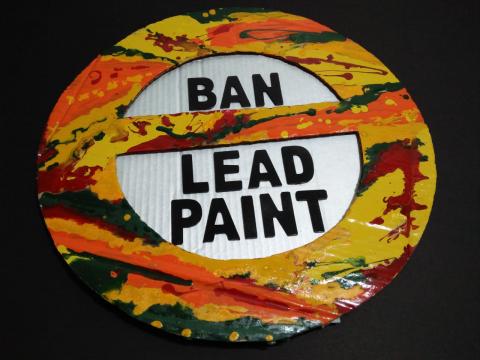IPEN POs in South and Southeast Asia Generate Fresh Data on Lead in Paints

Six IPEN Participating Organizations (POs) in South and Southeast Asia conducted new analytical studies on solvent-based paints, including industrial paints, that are sold in the local market. The studies show that lead paints are still manufactured and/or sold in countries where lead paint laws exist such as in Bangladesh, Nepal, Sri Lanka, Philippines, and Vietnam, and moreso in Indonesia which has yet to adopt a legally binding lead paint law. The results, released during the International Lead Poisoning Prevention Week, justify the POs’ continuing campaign to ban the manufacture, import, export, distribution, sale, and use of all lead-containing paints to protect human health and the environment.
BANGLADESH. The study conducted by the Environment and Social Development Organization (ESDO) with IPEN finds 20 out of the 63 analyzed solvent-based paints with lead content above 90 ppm, the mandatory total lead content limit for three paint standards as per Statutory Regulatory Order No. 221-Law/2018. Among these 20 lead paints are six products with extremely high lead concentrations above 10,000 ppm. The highest lead concentrations detected were 190,000 ppm in a yellow industrial paint and 52,000 ppm in a yellow decorative paint sold for home use. Both paints were manufactured in Bangladesh. On the other hand, 43 out of 63 paints had lead concentrations below 90 ppm indicating that paint manufacturers in Bangladesh are capable and technologically able to produce paints without added lead.
NEPAL. With support from the World Health Organization’s Country Office for Nepal, the Center for Public Health and Environmental Development (CEPHED) published two new reports that were released during the ILPPW. The report “Compliance Monitoring of Lead Paint Standard in Nepal” reveals that 30 out of 62 analyzed solvent-based paints contained lead concentrations above the regulatory limit of 90 ppm, with seven of such paints containing extremely high lead content in excess of 10,000 ppm. The highest lead concentration detected was 22,850 ppm in a yellow “Smart” paint. Thirty-two of the analyzed paint samples contained lead concentrations at or below 90 ppm, which indicates that non-lead paint technology is available in Nepal. The report “Study of Lead in Spray Paints in Nepal” found 14 of the 21 spray paints compliant with the lead paint standard. The rest of the paints exceeded the 90 ppm limit with two products containing extremely high lead concentrations above 10,000 ppm. The highest lead concentration detected was 15,618 ppm in a yellow “Lazer” spray paint from Nippon Paint China.
SRI LANKA. The joint study conducted by the Centre for Environmental Justice (CEJ) and Occupational Knowledge International shows that most paints have been reformulated to eliminate lead additives, but higher lead levels were found in some lacquers and anticorrosive paints used for metal surfaces. Out of the total of 37 paints tested, 14 percent contained lead concentrations in excess of 90 ppm. In addition, 36 out of 37 paints (97 percent of total paints) contained lead concentrations below 600 ppm, the legal limit for lead concentration in enamel and floor paints permitted to be sold within Sri Lanka. The study included brands from 25 paint manufacturers, 20 manufacturers of which were small- and medium-sized paint manufacturers (SMEs). The results further show that paints from 16 out of 20 brands manufactured by SMEs had lead levels below 90 ppm.
INDONESIA. The study undertaken by Nexus3 Foundation with IPEN found 88 of the 120 samples of solvent-based decorative and industrial paints with lead concentrations above 90 ppm. Forty-seven of the 88 lead paints contained extremely high lead concentrations surpassing 10,000 ppm. The highest lead concentrations detected were 250,000 ppm in a yellow road-line industrial paint and 150,000 ppm in a yellow decorative paint sold for home use. Two paints from the “Primatan” brand contained 12,000 ppm and 8,900 ppm lead levels despite having a “no added lead” claim on their labels.There is currently no legally binding regulation that prohibits the use of lead in paint in Indonesia.
PHILIPPINES. The study conducted jointly by the EcoWaste Coalition and IPEN generated the first publicly available data on the lead content of solvent-based industrial paints sold in the Philippines. Of the 68 samples of solvent-based industrial paints, 21 bright-colored paints were found to be lead paints, or paints containing lead concentrations above the maximum regulatory limit of 90 ppm. Moreover, 13 of these leaded paints contained extremely high lead concentrations above 10,000 ppm (nine of which had lead concentrations at or above 100,000 ppm). The highest lead concentration detected was 220,000 ppm in a yellow epoxy paint. On the other hand, 47 out of 68 solvent-based industrial paints contained lead concentrations at or below 90 ppm, suggesting that the technology to produce paint without leaded ingredients exists in the Philippines.
VIETNAM. A joint study by the Research Centre for Gender, Family and Environment in Development (CGFED) with IPEN found the lead levels in all 19 decorative paints and three anti-corrosive paints below 90 ppm. On the other hand, seven out of the 18 solvent-based industrial paints contained lead concentrations above 90 ppm. Three of these seven lead-containing industrial paints had extremely high lead concentrations above 10,000 ppm. The highest lead concentration detected was 92,400 ppm in a yellow industrial paint manufactured by a Vietnamese company, which is 150 times higher than the 600 ppm limit set under the National Technical Regulation on the Limits of Total Lead in Paints. With its adoption of a lead paint law last year, Vietnam became the third Southeast Asian country to establish a regulation after the Philippines in 2013 and Thailand in 2016.
